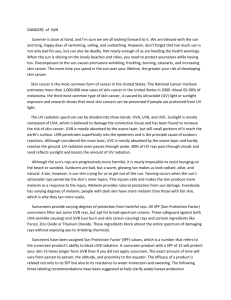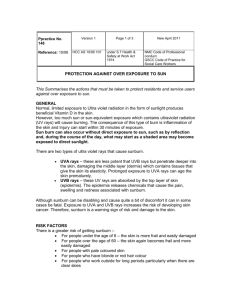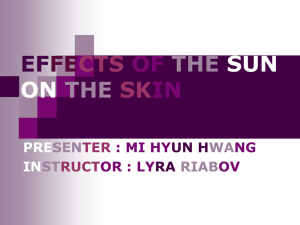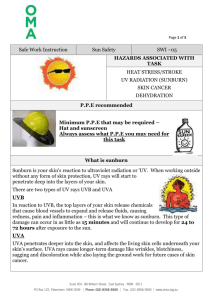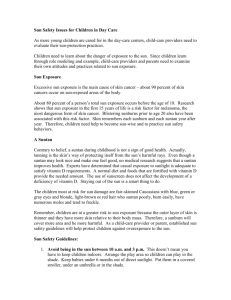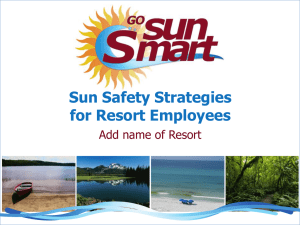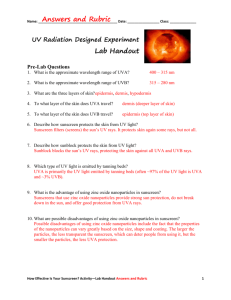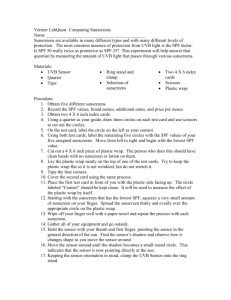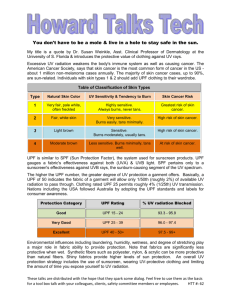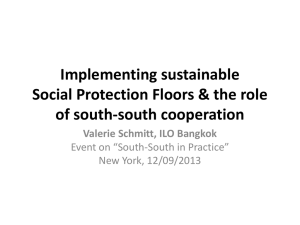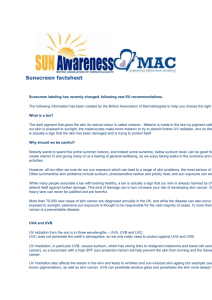Sun Safe Schools- Preventing Skin Cancer at Work Training Slides
advertisement
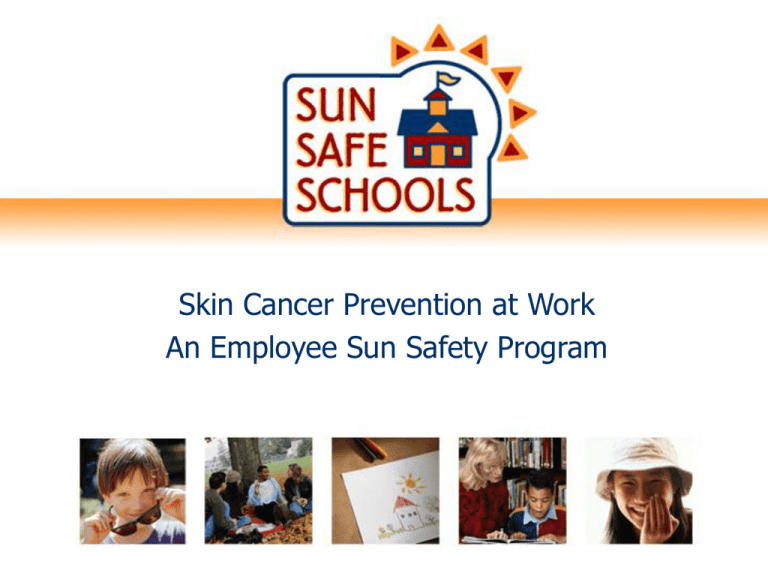
Skin Cancer Prevention at Work An Employee Sun Safety Program Introduction As an outdoor worker, you can take precautions to help protect yourself from ultraviolet radiation– the main cause of skin cancer. The following four modules will help you understand 1) your personal risk for skin cancer 2) how sun damages the skin 3) how to reduce sun exposure 4) how to spot skin cancer early Slide 2 The Sun: Benefits and Harms BENEFITS: Heat Light Photosynthesis Outdoor environment for physical activity Production of vitamin D Happy and positive feelings HARMS: Suntans Sunburns Skin aging Freckles Wrinkles Skin cancer Eye damage (Cataracts) Immune system suppression Slide 3 MODULE 1: Know Your Personal Risk Outdoor workers receive up to 8 times more UV than indoor workers and have a 60% greater risk of developing skin cancer. Slide 4 Personal Risk for Sun Damage Your risk of getting harmed from sun exposure is the sum of 3 components: Who You Are + Where You Live + What You Do = PERSONAL RISK FACTOR for sun damage Slide 5 Personal Risk Factors GENETICS (Who you are) Lighter skin, hair and eyes Family history of skin cancer ENVIRONMENT (Where you live) High Altitude Low Latitude Sunny Climate Ground Reflection GREATER RISK! BEHAVIOR (What you do) Unprotected time outdoors Especially in midday peak sun intensity hours Slide 6 What’s your skin type? I Always burns, never tans, sensitive to sun exposure II Burns easily, tans minimally III Burns moderately, tans gradually to light brown IV Burns minimally, always tans well to moderately brown V Rarely burns, tans profusely to dark VI Never burns, deeply pigmented, least sensitive Slide 7 Genetic High Risk Factors Blond or red hair Blue, green or gray eyes Fair skin Skin that freckles and burns easily Many moles; large moles Family members with melanoma Slide 8 Environmental High Risk Factors Altitude – In places with higher elevation the atmosphere becomes thinner and you are exposed to more UV rays. Latitude – Due to the angle of the sun, the closer you are to the equator, the more intense the sun's UV rays. Climate – Locations that have a lot of clear sunny days throughout the year are exposed to more intense UV rays than places with varying seasons. Slide 9 Behavioral High Risk Factors Do you stay out all day in the sun without protection? Do you sunbathe to get a tan? Do you sunburn? Do you go to a tanning salon? Slide 10 MODULE 2: How Sun Damages The Skin At least 90% of skin cancer is caused by ultraviolet radiation. Slide 11 Electromagnetic Spectrum Slide 12 Skin & UV UV Radiation is 95% UVA & 5% UVB. UVA causes tanning, aging & skin cancer. UVB causes burning & skin cancer. EPIDERMIS DERMIS Tanning beds emit 2-3 times more UVA than the sun. SUBCUTIS Slide 13 Suntans & Sunburns A suntan tells you that your skin is trying to protect itself from damaging UV rays. Suntans give a very small amount of protection from sunburn, but the skin gets damage while getting the tan, including aging from UVA rays and lifetime sun exposure. Sunburns cause wrinkles, premature skin aging and skin cancer. Avoid severe sunburns from intense, intermittent exposure to UV rays. Avoid continual exposure to UV rays over your lifetime. Slide 14 Skin Cancer Formation UVA and UVB rays hit the epidermis, reaching cellular DNA DNA in skin cells is damaged To prevent more damage, skin produces melanin (tanning) The immune system tries to repair damaged cells, but sometimes mistakes (mutations) are made Mutations can result in skin cancer within 5 years Slide 15 Skin Cancer Basal Cell Squamous Cell Melanoma Slide 16 MODULE 3: Reduce Your Sun Exposure Regular UV protection can reduce skin cancer risk by 80%. Slide 17 Limit Your Time In The Sun Schedule outdoor activities to avoid intense midday hours (10 am to 4 pm). Seek shade or go inside when you can. Shade can reduce UV by 75%. Eat lunch inside or in the shade. Use portable shade cover. Car window glass blocks UVB but not all UVA. Clouds block only 20-40% of UV. Slide 18 Check the UV Index daily Sun protection is needed when the UV Index is 3 (moderate) or higher. In Southern California, the UV Index average is 3 or above during the the months of February through November. Also, use sun protection at high altitude in the winter months. UV increases about 4-5% with every 1000 feet gained in elevation. http://www.epa.gov/sunwise/uvindex.html Slide 19 Sun Safe Clothing Clothing can block 100% of UV. Wear clothing that covers a large amount of your skin. Long-sleeve shirts and long pants are best. Choose clothing that is made from fabric with a tight weave that allows little or no light to pass through. Wear gloves to protect your hands. Choose wide-brimmed hats. Slide 20 What is UPF? UPF = Ultraviolet Protection Factor Like SPF for fabric Fabrics are not tested on humans like sunscreen The higher the UPF the more UV that’s blocked Sun protective = UPF 15 to 50+ White t-shirt = about UPF 5 Slide 21 The Sun Safety of Hats Choose wide-brimmed hats. But, any hat is better than NO hat! Slide 22 Sunglasses The eye absorbs >99% of UV. UV rays can: – harm your eyes – cause cataracts, macular degeneration & blindness Select and wear large sunglasses that block 99-100% of UV rays. Look for lenses that meet ANSI Z80.3 Darker lenses are not necessarily better. Expensive lenses are not necessarily better. Slide 23 Sunscreen Choose SPF 15 or more. Use “broad-spectrum” sunscreen UVA and UVB. Apply 15-30 minutes prior to sun exposure. Apply all over exposed skin, including your ears, neck and hands. Slop it on! – on average, you should use an amount the size of a large grape to cover your face, ears and neck. Reapply every two hours or more often after swimming or sweating. Choose water-resistant sunscreen. Make using sunscreen a habit. Slide 24 What is SPF? SPF = Sun Protection Factor SPF is a number that tells you how long a sunscreen will protect your skin from sunburn. SPF also tells you the amount of protection. – SPF 15 blocks 93% of UVB – SPF 30 blocks 97% of UVB – SPF 50 blocks 98% of UVB SPF is not a measure of UVA protection. However, most sunscreens do block UVB and UVA. Slide 25 Calculating SPF x Your Time To Burn Without Protection SPF of your sunscreen = ____ MINUTES UNTIL SKIN BURNS Example: 12 minutes x SPF 30 = 360 minutes (6 hours) until sunburn Slide 26 Australian Radiation Protection and Nuclear Safety Agency… “Reapply regularly, but remember that reapplication only keeps up the protection of the first application, it doesn't give you extra protection.” “If applying sunscreen of SPF 15+ gives you 2 hours in the sun without burning, then reapplying the sunscreen after 2 hours does not protect you for another 2 hours. You have already received a sunburn dose after the first 2 hours!” -- www.arpansa.gov.au Slide 27 Vitamin D Vitamin D sufficiency is important for overall good health. Most people can satisfy the body’s requirement for vitamin D from casual exposure to sunlight. – 10-15 minutes of sun exposure twice a week to the face, arms, hands, or back without sunscreen is usually sufficient to provide adequate Vitamin D. Obese, darker skinned and older people can be at risk for Vitamin D deficiency, but consumption of fortified mike or orange juice will provide the necessary amount of Vitamin D. Slide 28 MODULE 4: Early Detection At least 95% of skin cancer can be cured if detected early. Slide 29 Check Your Skin Look for changes in spots, moles or sores that do not heal. Use the ABCDE* rule for moles: – A is for Asymmetry: One half of the mole or birthmark does not match the other. – B is for Border: The edges are ragged, irregular, or poorly defined. – C is for Color: The color varies from one area to another; may have differing shades of brown or black, sometimes white, red or blue. – D is for Diameter: The area is larger than 6 mm (as a general rule, the size of a pencil eraser) and is growing larger. – E is for Evolving: If there are any changes in the size, color, shape or texture of a mole, the development of a new mole, or any other unusual changes in the skin, see your dermatologist immediately. *Source: American Academy of Dermatology, Skin Cancer Foundation Slide 30 How to perform a monthly skin check: Examine your body front and back in the mirror, then right and left sides arms raised. Bend elbows and look carefully at forearms and upper underarms and palms. Look at the backs of the legs and feet; spaces between toes, and sole. Examine back of neck and scalp with a hand mirror. Part hair for a closer look. Finally, check back and buttocks with a hand mirror. Consult a physician immediately if you have any doubt about a mole or changing spot on your skin. Slide 31 Summary EVERYONE needs to be sun safe. Avoid sunburning and suntanning. Wear sunscreen & lip balm with SPF 15 or higher Wear sun safe clothing, hats and eyewea Limit your time in the sun Practice early detection. Be a good role model for students. Slide 32 For More Information Contact: admin@sunsafeschools.net Slide 33
